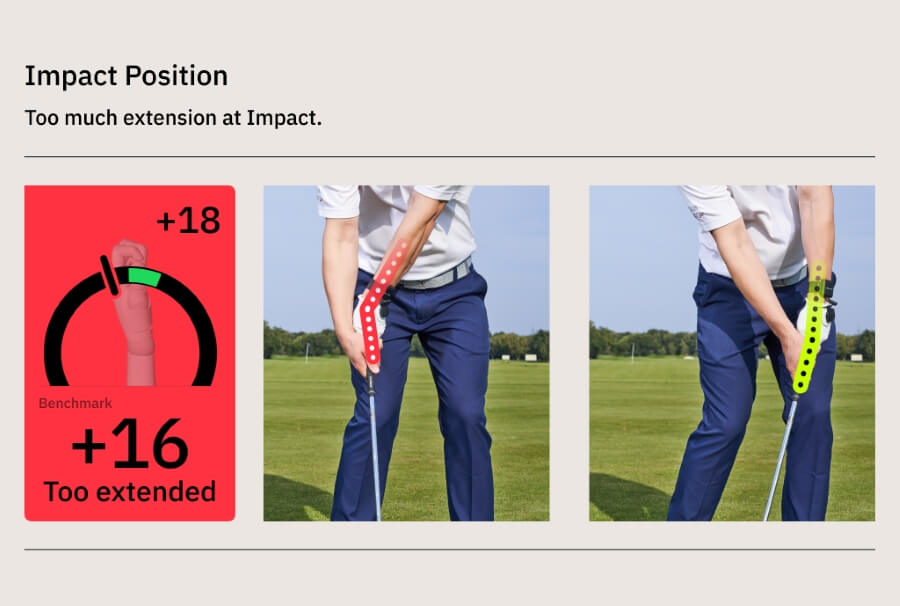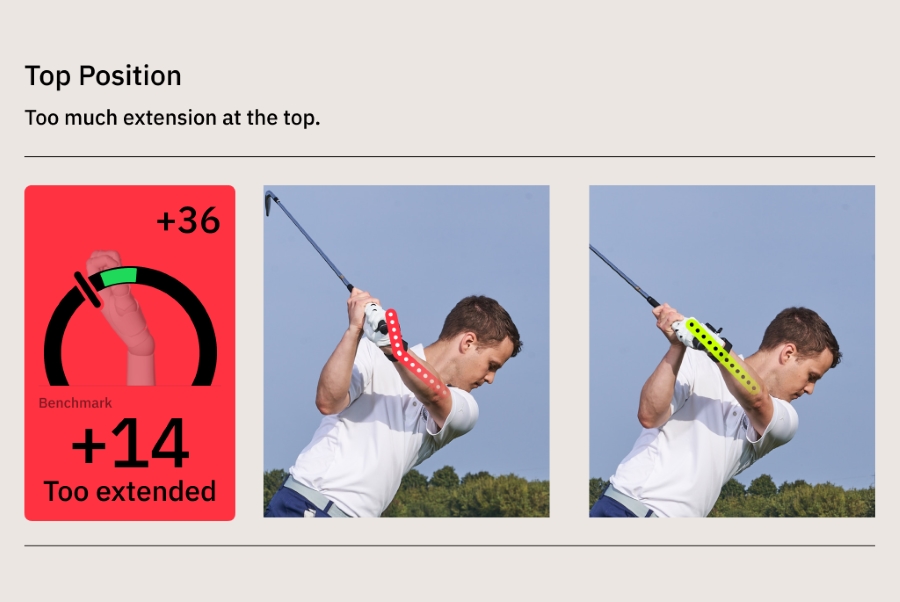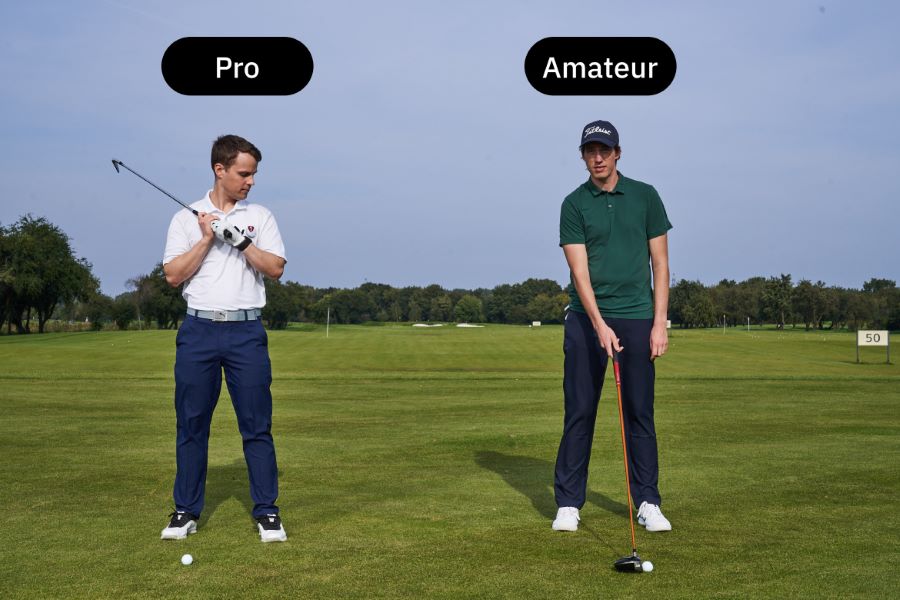How to Break 90 in Golf Consistently – The 20 Proven Tips for Better Scores
Breaking 100 in golf is a big deal, but golfers who learn to break 90 feel a great sense of pride. Let’s face it: an 88 is better than most golfers will shoot in their entire lives.
Golfers overcomplicate breaking 90.
Instead of focusing on actionable steps that can take your game to the next level, they focus on perfection. I’ll show you how to break 90 in golf consistently.
The process will take you from being a somewhat unaware amateur golfer to a player with a goal, a plan, and some understanding.
How to Break 90 in Golf Consistently (Key Takeaways)
If you are on a real journey to break 90 this season, save this guide. You can go through it one step at a time and make sure you have all the right thoughts and actions in place.
However, if you want the quick rundown of what you need to do to break 90, here it is:
- Use forgiving equipment to combat mishits.
- Use golf technology, like HackMotion, Video, and Launch Monitors, to eradicate common golf swing mistakes.
- Develop a pre-shot routine that includes visualization and prepare for each shot.
- Improve your short game to minimize leaked strokes on the green.
- Learn how to scramble and escape bad situations with a par score.
- Learn the relationship between wrist action and the angle of the clubface; too much flexion or extension in the lead wrist can cause problems in your game.
- Aim for the middle of the green to stay away from trouble, but still give yourself a chance at par.
- Spend a little time eating correctly and working out, when your body functions better you’ll play better golf.
Contents
- 20 Actionable Tips to Consistently Break 90 in Golf
- Use More Forgiving Clubs
- Find a Golf Shaft that Matches Your Swing Speed
- Develop a Pre-Shot Routine
- Practice with a Purpose (and Some Technology)
- Learn How to Scramble
- Take the Right Club
- Learn to Feel the Clubface
- Learn How to Chip
- Reduce Three Putts
- Play a Familiar Golf Course Frequently
- Warm Up Before Your Round
- Adjust Ball Position Accordingly
- Know Your Position at the Top
- Compensate During a Round for Any Unwanted Shape
- Aim for the Middle of the Green
- Understand the Green
- Play it Safe
- Work with an Instructor
- Have a Go-To Shot
- Invest in Technology to Improve Your Game
- FAQs
- Final Thoughts
20 Actionable Tips to Consistently Break 90 in Golf
Use More Forgiving Clubs
Modern game improvement golf clubs are built to mitigate slice shots, preserve ball speed and manage spin on mishits.
The equipment is available to you, so take advantage of it. Going for a custom club fitting can help you determine if your equipment is the right fit for you.
The bottom line here is that if your golf clubs are older and don’t have forgiveness built in, they could be the reason you are struggling to break 90.
Here are some examples of forgiving golf clubs that could help you when it comes to breaking 90:
- Drivers: Ping G430 Max, TaylorMade Stealth 2 Plus Driver, Callaway Paradym Driver, Cobra LTDx Max Driver
- Fairway Woods: Ping G430 Max Fairway, TaylorMade Stealth 2 Steel Fairway, Callaway Paradym Fairway, Titleist TSR 2 Fairway
- Hybrid: Titleist TSR2, Callaway Men’s Paradym, TaylorMade Stealth 2 Rescue
- Irons: Ping i230, Titleist T300, Mizuno JPX Forged, TaylorMade P790
- Wedges: Callaway Jaws MD5, Ping Glide Forged Pro, Cleveland RTX 6 ZipCore
- Putters: Ping Anser, Odyssey Toulon Series, Cleveland HB Soft Premier

Find a Golf Shaft that Matches Your Swing Speed
If you swing with more than 100 miles per hour of speed in your driver, you should have a stiff shaft in your golf club.
However, if you can’t quite get these speeds, don’t be afraid to go with a regular or senior shaft.
Too many golfers looking to break 90 have a shaft that is not flexible enough to promote forgiveness.
The increased flexibility gives golfers added spring into impact for exceptional energy transfer and rapid ball speed.
Here is a basic idea of what shaft flex you could need for every swing speed:
| Swing Speed (mph) | Recommended Shaft Flex | Description |
|---|---|---|
| Below 70 | Ladies (L) | Very flexible, promotes higher launch |
| 70-80 | Senior (A) | More flexible than regular, aids in distance |
| 80-90 | Regular (R) | Balanced flexibility for control and distance |
| 90-100 | Stiff (S) | Less flexible, more control, lower ball flight |
| Above 100 | Extra Stiff (X) | Very stiff, maximum control, lower ball flight |
Develop a Pre-Shot Routine
The pre shot routine helps you clear the last shot from your mind, get set to hit this next shot and finally it helps you envision your next shot and plan out the hole in front of you.
A common pre shot routine is to take one practice swing standing, looking down the line at the target. Then line up the clubface, come around the golf ball, look back at the target and then take your shot
You can work to make the pre shot routine more specific to your game, but the most important aspect is that you have one.
Practice with a Purpose (and Some Technology)
When you visit the golf driving range, avoid continually hitting shots without a plan in place.
Simply hitting golf shots is really more of a form of exercise than it is an actual attempt at getting better at golf.
Practice with technology like the HackMotion on the driving range. You can tag each practice session to know exactly what you were working on and decide if it’s making a positive impact in your game.
Learn How to Scramble
Do you ever find yourself in the rough or blocked out behind a tree because of your tee shot? This is common in your handicap range, and learning how to scramble could be the way to fix it.
Scrambling is learning how to get up and down from anywhere within 100 yards.
To become better at scrambling, work on golf shots from 50 yards and in, as well as vary the ball flight of your shots. Try to learn the low punch to get you out of trouble.
Also, try to make some 8-10 foot putts; sometimes, a good scramble takes a solid putt.
Take the Right Club
Golfers yet to break 90 may fall victim to incorrect club selections and distance readings.
Most golfers under club themselves. Learn your carry distances and know them well. If you hit a 7 iron 150 yards, you probably carry it about 145 yards.
Therefore you may want a 6 iron if there is trouble short of the green.
Learn to Feel the Clubface
The clubface is what controls the direction of your golf ball. If the clubface is open at impact, the ball goes right; if it’s closed at impact, the ball goes left. If you want to break 90 in golf, you have to have some idea of what the clubface is doing.
HackMotion can teach you how to control the clubface. Start by taking some swings and gathering data. The key data point to look for is the extension in your wrists.
Golfers with too much extension at the top of their backswing often have too much extension at impact, leaving the clubface open.
Many golfers who shoot in the 90s and 100’s still don’t know how to feel the clubface or how to control it.
Working with a feedback tool like HackMotion can get you there and have you playing more deliberate and better golf.

Learn How to Chip
You are going to miss greens from time to time, a good chip. Learning to chip goes a long way to helping you set up for an easy, makeable one-putt and save par or a bogey.
I recommend keeping it simple with low chips or a bump-and-run shot. The lower you keep the ball, the safer it is.
Keep your lead wrist more flexed when you take a chip shot; you’ll get much more consistency.
Reduce Three Putts
You have likely heard many commentators and coaches harp on the importance of your putting stroke, and they are right.
Golfers with a handicap of 20 to 25 three putt 19.1% of the holes they play. In addition, those with a handicap higher than 26 record three putts on 25% of their holes.
According to Shot Scope.
HackMotion can be used on the putting green to develop more consistency in your stroke.
There is no perfect wrist angle in putting, but you can learn to keep yours more consistent and reduce the number of times you three putt.

Play a Familiar Golf Course Frequently
One way to help finally break into the 80s in golf is to frequently play your home golf course to increase your confidence.
Frequenting the same club allows you to gain “member’s knowledge” and learn where to land your ball on different holes to enjoy the assistance of the layout.
The more you play the same course, the easier it becomes to make better-informed club selection, which leads to improved distance control. Take these strategies with you when you travel to other courses.
Warm Up Before Your Round
Amateurs are notorious for skipping warm-up and heading straight to the first tee to let their driver rip.
This leaves you at risk of injuring your back, neck, and knees. It also hampers you from producing optimal rotation and power during your swing.
- Do some stretches to help move your arms, shoulders, back and hips.
- Hit a few balls at the driving range.
- Make some smaller chip shots.
- Finish with at least 10 putts from varying lengths.
Instead of getting to the 4th hole and finally feeling warmed up, you’ll be ready to go right from the start.
Adjust Ball Position Accordingly
At this point of your golf career, you are likely familiar with the front, middle, and back ball positions.
However, you probably still get it wrong every now and then, which causes you to top, chunk, or slice your ball.
A simple rule of thumb is to start with the ball on the inside heel of your lead leg for tee shots. Next, you move it marginally back for fairway wood strikes and keep the sequence going until it sits mostly in the middle for short irons and wedges.
Know Your Position at the Top
Do you know where the club is when it’s at the top of your backswing?

Most golfers have no idea where the club is, and because of that, they end up with a clubface that is open or closed.
Start practicing with the HackMotion and pay very close attention to the position you are in at the top of your backswing.
If your wrist is flat or there is a bit of a flexed position, you are in a great spot. With a lot of extension, you have your work cut out for you.
Compensate During a Round for Any Unwanted Shape
If you are in the middle of a round and a problem comes up, start making simple adjustments until you can fix it after the round.
Aim a little left if you need to, put the driver away, and take a 3 wood out, etc.
Make a slight change so you can get through the round and then head to the driving range and check on what the issue could be.
Compensating from one round to the next is not a smart idea but mid round you have to work with what you have that day.
Aim for the Middle of the Green
Avoid attacking the flag on approach and aim for the middle of the green. You are not a low handicapper or professional who needs birdies.
To achieve your goal, you need bogies and the odd par. If the par total at your home course is 72, then +17 is good enough to break 90.
Therefore, 17 bogies and a single par are all you need. This is why you can afford to aim for the middle of the green.
Understand the Green
Knowing how the green slopes can play into your favor on approach if you land the ball in the correct area.
In addition, it is crucial to better your green reading ability to know which way and how fast a putt breaks.
Using the slopes and the speed of the green to your advantage enables you to position yourself optimally for each putt and reduce three putts to avoid leaking strokes.
A simple misread of the green can send your golf ball several feet in the unintended direction, leaving the door open for a three putt.
Play it Safe
Birdies and eagles are not required to help you break 90, but a round with main bogies and the odd par will get you there.
To finally break 90, you need not do anything aggressive.
A solid 5 wood or hybrid off the tee leaves you a long but achievable approach shot, but if you miss, you have a chip shot to get up and down for par or a bogey.
On a difficult par 4 I encourage you to think about playing for a 5; it’s not going to hurt your quest to break 90.
Work with an Instructor
I often meet high handicappers who have never had a lesson from a certified instructor and wonder why they are struggling.
These players are typically coached by their buddies on the course, who are also standard, casual golfers making the same mistakes.
Working with an instructor for a few lessons gives you deeper insight into the mechanics of your swing and the subsequent outcome.
In addition, your coach will help you route out common golf swing mistakes and provide solutions and drills to eradicate them for good.
Until you seek the assistance of a professional, you will continue to make annoying errors that make it difficult to break 90.
Have a Go-To Shot
When your golf ball is in a tough spot or your swing feels off, have a go-to shot that you can trust.
Typically speaking this is something where you choke up on the club, shorten the swing and get the ball back into play. When you have this your chances of being able to break 90 and keep the ball in play is greatly improved.
Invest in Technology to Improve Your Game
With the amount of technology available to help you become a better golfer, you will find that there are some investments that can help you break 90 with ease.
There are countless swing aids around, but very few are designed to prevent the root cause of erratic golf shots.
Your hands are the only element of your body that connects with the golf club, and your wrist angles impact the clubface angle during the swing.
HackMotion helps golfers of all skill levels achieve the correct wrist angles through the swing, which prompts the body to fall into place and follow suit.
The clubface determines 80% of the golf ball’s direction, and when your wrists are out of position, it hampers the clubface angle.
As a result, HackMotion measures your wrist angles, delivering immediate feedback to optimize the accuracy and power of every swing.
FAQs
Is it hard to break 90 in golf?
Yes, it is hard to break 90 in golf because it takes time, practice, intelligent planning, and the correct equipment. Backing up these claims is the fact that only 26% of golfers break 90.
However, once you understand your swing and the game, it becomes easy to break 90 by playing safe, aiming for the middle of the green, and improving your short game.
How long should it take to break 90 in golf?
It can take a month or years to break 90 in golf. It comes down to talent and hours of practice invested in the process. Progress can speed up using technology such as HackMotion to improve your swing mechanics.
What percentage of golfers in the world can break 90?
According to the PGA, only 26% of golfers break 90, while 29% of all amateurs consistently shoot between 90 to 99.
How do you practice breaking 90?
You practice breaking 90 by working on your short game and scrambling to help you escape challenging situations and get up and down from the greenside. Next, golfers need to learn to control the clubface so that they can hit straight golf shots.
Final Thoughts
Learning how to break 90 in golf is a process and typically takes golfers several months or years to master.
However, if you play with forgiving clubs and the correct shaft flex, master your short game, and play it safe, you will break 90 shots consistently.
Learning how to control the clubface now will also get you closer to breaking 80!















